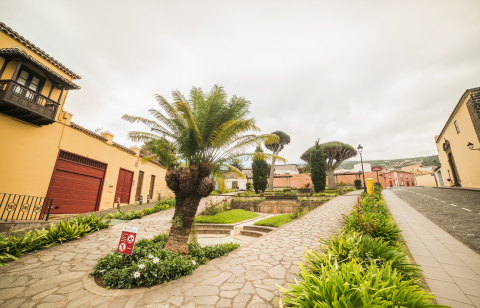8. San Francisco square and the former San Lorenzo Convent

In the 16th century, Bartolomé Benítez de Lugo encouraged the construction of the now-disappeared convent of San Lorenzo here, which was run by the Franciscan order. This cobbled street is the starting point of the traditional pilgrimage of San Isidro Labrador. If you are lucky enough to come between the end of May and the beginning of June, your visit may coincide with this holiday, when the people of La Orotava dress in typical costumes to accompany their patron saint with song, wine and food. This holiday to homage the patron saint of La Orotava, which is celebrated on the eight day of Corpus, is characterised by the blessing of fruit and cattle, recalling the native rituals that took place on these dates close to the summer solstice.
It’s not strange that Saint Isidro, protector of farmers, is the patron saint of a fertile area like La Orotava, since its main wealth came from agriculture until the mid-20th century.
In front of the square are the San Francisco Church and the site of the former Santísima Trinidad Hospital. This complex is just one testimony of the huge San Lorenzo Convent, a monastery of such importance on the island that it was given the name ‘El Escorial of the Canaries’.
At the beginning of the 16th century, the conqueror Bartolomé Benítez de Lugo financed the construction of the convent in the same place as the San Lorenzo Chapel after two events that affected him deeply. It’s said that one night while sleeping, Bartolomé Benítez de Lugo had a vision in which a Franciscan monk approached him amid the flames of a fire, warning him to get up before the house burned down. Bartolomé woke up and found himself actually in flames, so he invoked Saint Lorenzo and the fire died down immediately. On another occasion, he was sent news that a sugarcane plantation on his property was burning, so he went there quickly, again imploring the aid of San Lorenzo. At that moment, a Franciscan appeared to extinguish the flames using only a green palm. After these events, Benitez de Lugo undertook the construction of the convent, which another terrible fire completely ruined at the beginning of the 19th century.
After this last fire, the current architectural complex was built over its site, in which parts of the old convent were reused, such as the stonework on the church. The Franciscans returned, but only for a short time, since they were affected by the Spanish Confiscation and had to leave the new building in 1836. At present, the complex is divided into two spaces. On the right, you can see what was a geriatric hospital run by the Sisters of Charity until the first decade of the 21st century, nowadays a municipal funeral home. On the left, there is the San Francisco Church, a typical Mudejar-style church with a single nave, devoted to the worship of the Virgin of Charity.
If the entrance to the old hospital is open, walk through and you’ll come to a small viewpoint from which you can see part of La Orotava and the cemetery that you’ve just come from. Once inside, you’ll see a stairway on your left carved in reused stone from the old San Lorenzo convent.
At the end of the staircase, embedded in the door, you’ll see a hatch from the late 19th century, where new-born babies were abandoned to the care of the nuns. Child abandonment was not uncommon among wealthy classes when there were pregnancies outside of marriage, both among wealthy young women and maids, who were abused by their masters. The hatch remained in operation until the 1960s.
Let’s now go up the street to the San Francisco Church.
